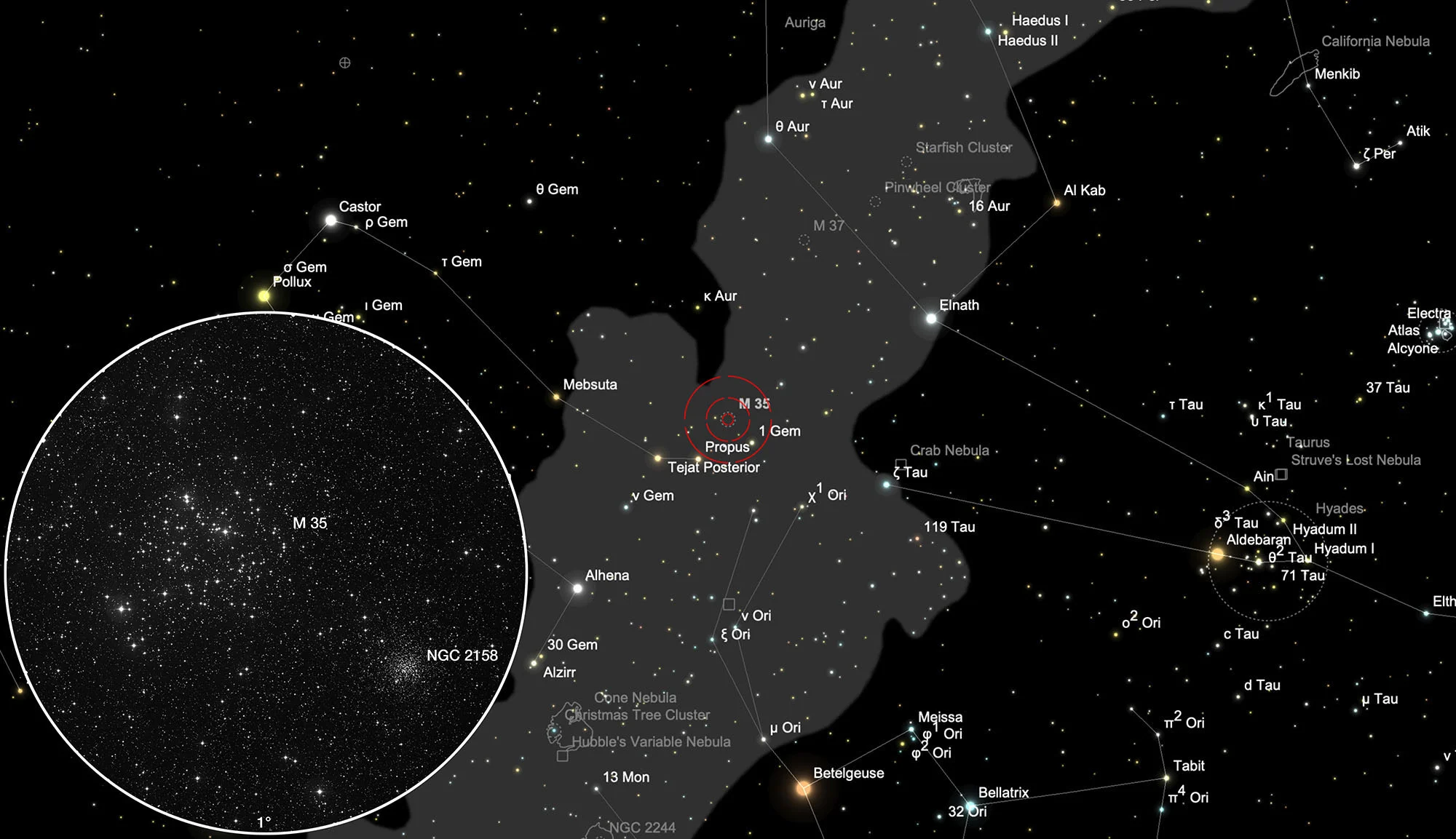Open Clusters M 35 and NGC 2158

Messier 35
The open star cluster M 35 was discovered by the Swiss astronomer Philippe de Cheseaux in 1745. He stated its location as «over the northern feet of Gemini». Although he did not give any coordinates, the identification seems certain. Messier noted that the star cluster was listed in Jon Bevis' 1750 star atlas, along with several other bright nebulae and star clusters known at the time.
M 35 is approximately 830 pc to 1185 pc (2700 to 3800 light years) away. Its core is about 20 minutes of arc in diameter. Scattered outsiders reach out about twice as much. These apparent sizes correspond to about 15 and 30 light years. About 120 of a total of about 500 stars in the cluster are brighter than magnitude 13. The hottest stars belong to spectral class B3, but there are also some yellow and orange giants of type G and K to be found. The age is estimated to be around 100 million years. Studies of the speed distribution show that in the central area of 10 light years there are about 2000 solar masses and the entire cluster has about double that. [4, 145, 196]
| Designation | NGC 2168 |
| Type | OCL (III2m) |
| Right Ascension (J2000.0) | 06h 09m 00.0s |
| Declination (J2000.0) | +24° 21' 00" |
| Diameter | 25 arcmin |
| Visual magnitude | 5.1 mag |
| Metric Distance | 0.830 kpc |
| Dreyer Description | Cl, vL, cRi, pC, st 9...16 |
| Identification, Remarks | M 35, OCL 466 |
NGC 2158
About half a degree southwest of M 35 lies NGC 2158, discovered by William Herschel on 16 November 1784 using his selfmade 18.7 inch reflecting telescope. He cataloged it as VI 17 (class VI = very compressed and rich clusters of stars) and noted: «A very rich cluster of very compressend extremely small stars. 4' or 5' diameter. A miniature of the 35 cluster of the Connoissance des Temps which it precedes 1' 18" and is 2' north.» [463]
NGC 2158 is a very rich and distant star cluster. Several thousand stars in an area of about five minutes of arc. The unusually large number of stars and their symmetrical distributions suggest that this is an intermediate stage from an open star cluster to a globular cluster, but the cluster does not show the central density typical of globular clusters. The cluster is estimated to be over a billion years old, so the hottest stars in the main sequence are F0-type and it has many orange and red giants. Too young for globular clusters, which are about ten times as old. Distance measurements show a distance of 4000 pc to 8472 pc (13'000 to 27'000 light years). The star cluster is thus on the outer edge of our galaxy. [4, 145, 196]
| Designation | NGC 2158 |
| Type | OCL (II3r) |
| Right Ascension (J2000.0) | 06h 07m 25.6s |
| Declination (J2000.0) | +24° 05' 46" |
| Diameter | 5 arcmin |
| Visual magnitude | 8.6 mag |
| Metric Distance | 4.980 kpc |
| Dreyer Description | Cl, pS, mC, vRi, irr Δ, st eS |
| Identification, Remarks | OCL 468 |
Finder Chart
The cluster is located in the constellation Gemini. Best observing season in Switzerland and other locations at roughly the same latitude is October through April.

Visual Observation
400 mm aperture: The two clusters show an impressive view using the 21 mm Ethos eyepiece at 85x magnification. They both fit into same field of view. I like the contrast of an loose open cluster with bright stars (M 35) between a smaller, denseer open cluster with fainter stars (NGC 2158). Some reddish and blueish stars pop out in M 35. — Taurus T400 f/4.5 Dobsonian, Bernd Nies, Glaubenberg Langis, 28 February 2022